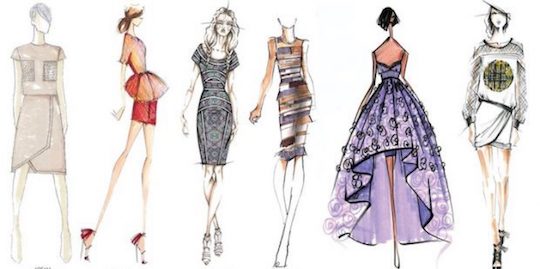When I was in college, I met a friend who is a recognised Fashion designer in South Africa. Since we were both involved in a creative department I had the opportunity to closely observe her creative process and see her bring beautiful outfits to life. So this article will be based more or less on that experience, but it will also mention other aspects to take into account when it comes to designing clothes.
Creating a design
It all starts with a concept, something that sparks the creativity of the designer. It could be an image, a shape, a word or idea, it could be a feeling, and even a colour. The design starts with that one thing that you would like the piece of clothing to communicate. My friend’s project consisted on designing dresses for a women’s conference, so her job was to communicate what womanhood represented.
I remember her spending hours and hours in her workshop trying to think what being a woman involved, she listened to songs, she thought of different people and probably even read poems to inspire herself until slowly one by one she drew what each of the dresses she was working on would look like. One of them seemed to express gentleness, since it was made out of soft colours and flowers, the other one expressed boldness, with black and white tones and filled with words of a bold statement. The other one made me think of spring, since its shape was fun and filled with vivid colours.
After drafting all these, and presenting them for approval, the designs started the process of coming to life.
Choosing materials
Materials communicate a lot believe it or not. The feel of the clothing you create mixed with the colours you choose defines the character of your piece. For example, if you would like to create something that gives a comfortable and free look, you would choose softer fabrics with a lot of movement. On the other hand if what you are looking for is to make a bold statement, you might want to use harder fabrics that create a shape by themselves.
Embellishments are also an important part of the designing process, there are countless materials you can use and combine in order to highlight certain areas of the piece of clothing or compliment it.
When choosing materials you would also want to consider the usage of the clothes, who is going to wear it and what for? Then you can define if comfort is more valuable than the looks of the material or if the impression should take the first place.
The Canvas
In Fashion the human body is the canvas you get to work with. As a designer you have the ability to highlight, hide and take advantage of different areas of the body. You can use the length of tall people to showcase certain pieces and the size of shorter people to showcase different concepts.
Unlike models what models seem to teach us, there is not really a standard canvas. The perfect body shape does not exist, but instead we have a great variety of blank pages available and ready to use to show our creativity. Larger sizes will challenge you to create something functional and beautiful at the same time, while smaller sizes will challenge you to fill up what seems to be lacking.
In fashion luckily you get to work with a living canvas, and through lighting effects, backdrops, movement, hair and make up, you can create a stunning piece of art like no other.
Fashion ethics
No form of art can exist unless you can finance it. And the fashion industry requires a huge investment in order to be successful and this is where fashion ethics play their part. As a designer you might naturally want to produce the biggest amount of clothing for the less amount of money, this sounds like business, but what lies behind such ambition is an issue that both designers and buyers need to be aware of.
The truth is that in order to make a cheap product, budget cuts need to be made in the production line and such cuts usually affect both the quality of the material and the value of the labor. Cheap labour is a huge problem specially in third world countries in which garment workers are paid under 80 cents an hour. They are also exposed to dangerous and harmful working conditions and this problem affects both adults and children since child labour is also very common in garment factories.
So designers and buyers, your responsibility stands in the fact that you need to know whether the clothes you buy or produced are ethically made for which you can visit the following website in South Africa: http://goodonyou.eco.
Hope this helped! What else do you know about fashion design? Let us know!


